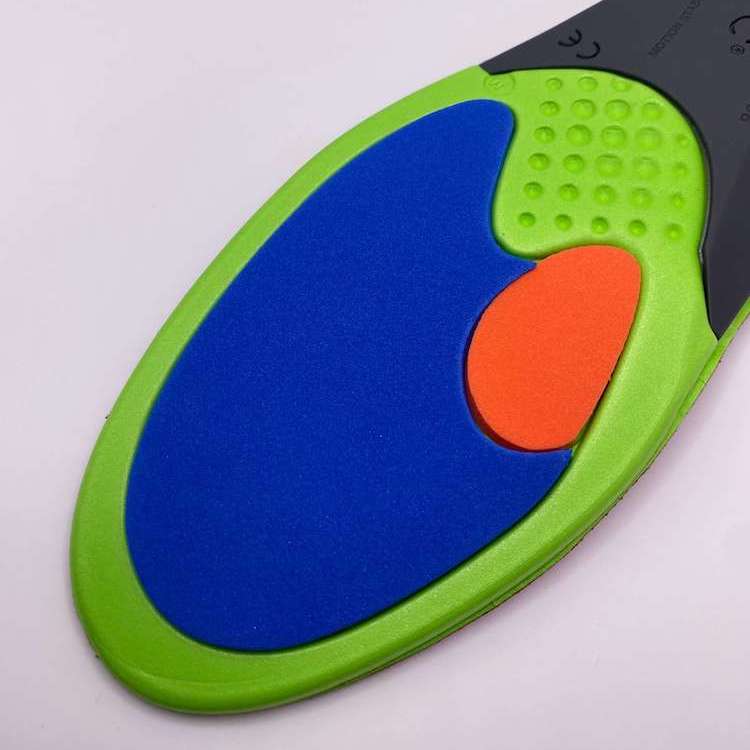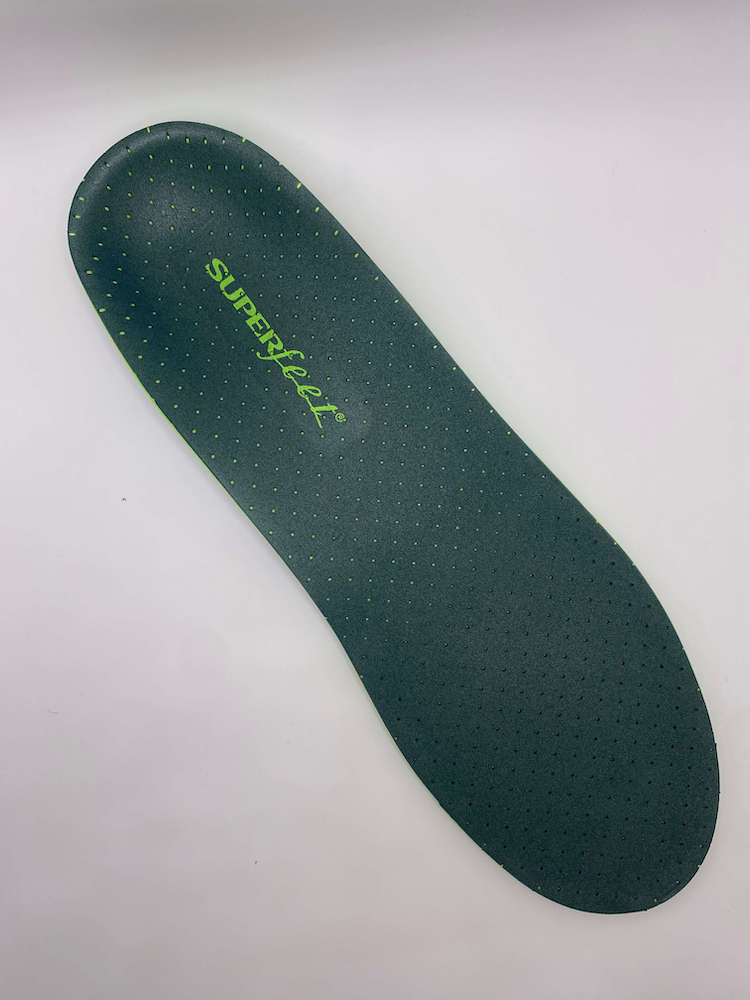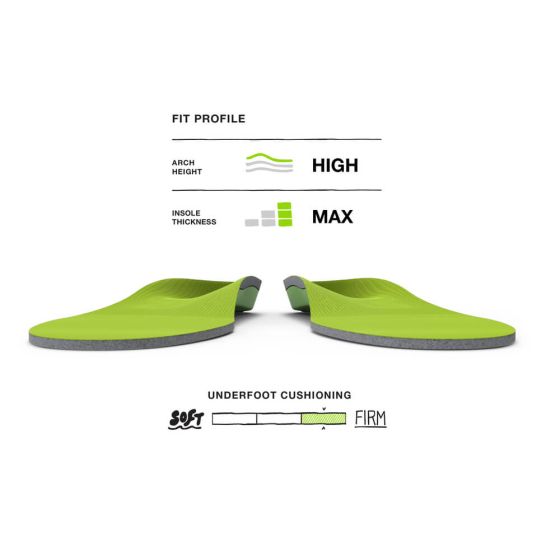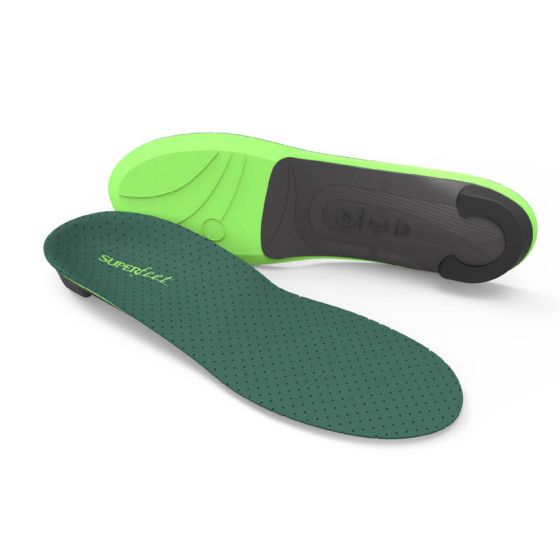free shipping desktop
The Anatomy of a Good, Supportive Insole

The insole is an important component for support and cushioning of a shoe. Insoles vary greatly in levels of support, materials, and design features. For example, supportive insoles are essential to providing overall stability, support, and cushioning when feet are in motion and are key to preventing foot discomfort, especially for those who spend long hours on their feet or are experiencing foot pain.
Some shoe brands come standard with insoles designed to offer therapeutic comfort and support. However, many shoe brands do not design the footbeds to anatomically support your feet while wearing. Not everyone needs supportive insoles; if your feet are naturally healthy and well-aligned, the additional support may not be necessary.
For those in need of a supportive insole, there are some specific features and designs that can provide therapeutic benefits. While not every feature may be necessary for your feet, we will look at each feature of a supportive insole and provide the condition it is designed for.
What Makes a Supportive Insole
Contoured Design

An insole with a contoured design is shaped to support the natural curves of your foot. Generally, the design will have a deep heel cup with a raised arch area. The shape of this insole helps to promote better lower body alignment and reduces strain. Anatomically positioning your feet can help distribute weight more evenly across the foot to eliminate pressure points and reduce discomfort.
Foot conditions used for: Flat Feet, Plantar Fasciitis, Metatarsalgia, Overpronation (excessive roll in), Supination (excessive roll out).
Arch Support

Arch support plays a crucial role in providing structural support to the foot’s arch. A good arch support will help with proper alignment, stability, and weight distribution. By supporting the arch area, the natural alignment of the foot is maintained to prevent excessive inward rolling and outward rolling of the foot.
For those with flat feet, a more rigid arch support may be necessary to support the lack of a natural arch. Without an arch, more strain is caused to the foot’s ligaments and tendons that can cause other foot problems, like plantar fasciitis (inflammation to the band of tissue that connects heel to toes).
There are varying levels of firmness in arches. A more rigid arch support is suggested where greater stability and motion control of the foot are necessary or if you have a high arch.
Foot conditions used for: Flat Feet, Plantar Fasciitis, Overpronation (excessive roll in), Supination (excessive roll out), and various other foot conditions related to foot mechanics.
Deep Heel Cup

A deep heel cup refers to the shape of the insole’s heel area that is designed to cradle and limit motion at the heel. This design allows your foot to be positioned more naturally preventing lateral (side-to-side) and medial (inward) movements that can occur while moving.
Foot conditions used for: Flat Feet, Plantar Fasciitis, Overpronation (excessive roll in), Achilles Tendonitis, and various other foot conditions related to foot mechanics.
Stabilizer Shaft

A stabilizer shaft, also known as a medial post or stability feature, is a structural component often found extending from the heel to the midfoot or arch area of an insole or orthopedic shoe insert. Its primary purpose is to provide reinforcing support at the arch and control motion, particularly addressing issues related to overpronation or excessive inward rolling of the foot during gait.
The material of the shaft is generally more rigid than the surrounding insole. Common materials can include a dense foam or thermoplastic. The thickness of the shaft can vary. Some stabilizer shafts are low-profile while others are more prominent depending on the level of support needed.
Foot conditions used for: Overpronation, Plantar Fasciitis, Flat Feet (excessive roll in), Achilles Tendonitis, and various other foot conditions related to foot mechanics.
Heel Cushioning

Heel cushioning in an insole provides essential support to the heel area, offering impact absorption, comfort, and relief for various foot conditions. An insole with heel cushioning will often have a pad at the heel area that can be made from various materials. Common materials for the cushioning pad are gel or foam (memory foam, EVA or polyurethane foam).
In a natural gait, the heel strikes the ground causing impact to your feet. A heel cushioning pad helps to absorb the impact and reduces stress on the heel and the lower body, thus preventing foot fatigue. This feature can be especially beneficial for those that are on their feet for prolonged periods and experiencing heel pain or discomfort.
Foot conditions used for: Heel Spurs, Plantar Fasciitis, Fat Pad Atrophy, Achilles Tendonitis, and general heel discomfort.
Metatarsal Pads

Metatarsal pads in an insole help to provide relief to discomfort in the metatarsal region, which includes the bones and joints of the forefoot. The material of a metatarsal pad can be foam (memory foam, EVA, or polyurethane foam) gel, or silicone.
The pad helps to cushion and alleviate pressure on the forefoot area as it impacts the ground while moving. Individuals experiencing forefoot pain, metatarsalgia, or related conditions may find relief and improved comfort by using insoles with appropriately positioned and designed metatarsal pads.
Foot conditions used for: Metatarsalgia (Ball of Foot Pain), Morton’s Neuroma, Bursitis, Splayfoot, and Capsulitis.
Anti-microbial and Moisture Wicking Fabric Lining

The fabric lining of an insole is the material that covers the top of the insole and comes in direct contact with your feet. The choice of fabric lining depends on the intended purpose of the insole and the desired characteristics, such as breathability, moisture management, and overall comfort.
Our feet naturally sweat inside shoes so choosing a fabric lining that wick away moisture and offers anti-microbial properties. These features will help extend the lifespan of the insole and improve your overall foot health.
The anti-microbial fabric helps prevent the growth of bacteria and fungi on the insole, thus providing odor control. It also contributes to better foot hygiene by minimizing the risk of fungal and bacterial infections, including athlete’s foot.
Anti-microbial fabrics often have moisture-wicking properties that help keep the feet dry as they sweat. Damp and sweaty feet not only create conditions in shoes conducive to microbial growth, but can lead to foot discomfort from blisters or skin irritation.
Foot conditions used for: Foot Odor Control, Athlete’s Foot, Fungal Nail Infections, Diabetic Feet, and for those with sensitive skin.
Trimming a Replacement Insole
Sometimes shoes can last longer than the insoles of a shoe. If your shoe has removable insoles, you can replace them with replacement inserts. Since replacement insoles can come in a range of sizes or can be shaped differently than your current insoles, you may need to trim your new insoles to fit inside your shoe.
Below are 3 simple steps to trimming your new insoles to fit inside your shoes.
- Remove your current insoles from the shoe.
- Align the current insoles to the new insoles to use as a template for trimming. Pro tip: use the opposite pair of the insole and align the bottoms for the perfect template.
- Using scissors, trim the new insole at the toe area to match your current insoles.
Getting Used to Supportive Insoles
Getting used to new supportive insoles may take some time as your feet and body adjust to the changes in support and alignment. Here are some tips to help you transition comfortably to new supportive insoles:
- Gradual Introduction: Start by wearing the new insoles for short periods initially. Gradually increase the time you spend wearing them each day. This allows your feet and muscles to adapt gradually without causing excessive discomfort.
- Wear Them in Comfortable Shoes: Choose shoes that are already comfortable and have enough room to accommodate the new insoles. Avoid tight or constricting shoes during the initial adjustment period.
- Use Them During Low-Impact Activities: Begin by wearing the insoles during low-impact activities such as walking. This allows you to experience the support without putting too much strain on your feet immediately.
- Consider Customization: If the insoles have customizable features, such as removable pads or adjustable arch support, experiment with different configurations to find the most comfortable setup for your feet.
- Orthopedic Advice: If you continue to experience discomfort or if you have a pre-existing foot condition, consider seeking advice from a podiatrist or orthopedic specialist. They can provide guidance on proper insole use and offer recommendations tailored to your individual needs.
The time it takes for feet to fully adjust to new, supportive insoles can vary widely from person to person. It can take days to weeks, but most people start to notice an improvement in comfort and adaptation within the first week.
Remember that the discomfort experienced during the initial period is often temporary, and it's a sign that your feet are adjusting to the new support. However, if you experience sharp or prolonged pain, it's important to address any concerns promptly.
Conclusion
In conclusion, a good insole combines supportive features, arch support, deep heel cups, and cushioning to provide optimal comfort and foot stability. Investing in quality insoles can make a significant difference in overall foot health, reducing pain and improving mobility.
About author:
Derek Roach is a foot health expert with over a decade of experience in the orthopedic shoe industry. He has helped thousands of customers find the right footwear for their unique foot conditions. His expertise has been featured in major publications such as CNN, Women's Health Mag, HuffPost, and Healthline. Passionate about foot health and comfort, Derek provides practical advice to help people improve mobility and reduce foot pain through proper footwear choices.











